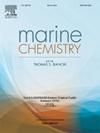Biogeochemical sulfur transformations in the cohesive and permeable tidal flat sediments of Jade Bay (North Sea)
IF 3
3区 地球科学
Q2 CHEMISTRY, MULTIDISCIPLINARY
引用次数: 0
Abstract
Intertidal flats are highly productive coastal marine ecosystems which are affected by fast changes in environmental conditions and host dynamic biogeochemical cycles in their sediments. Bioturbation by burrowing organisms and roots of plants strongly affects speciation and cycling of redox-sensitive elements in intertidal sediments. In this work, we have studied the impact of sediment type and vegetation on the cycling of redox-sensitive elements including sulfur, iron, and manganese in sandy and muddy tidal flats sediments in the Jade Bay (North Sea) and adjacent area. The redox speciation of these elements was analyzed in the pore-waters and the total sediment. The isotopic compositions of sulfur species were measured in non-vegetated sediments and in sediments which are inhabited by various plants. In the cohesive sediments, which are not affected by vegetation, a decrease in sulfate concentration, coupled with the presence of relatively high concentrations of hydrogen sulfide in the pore-waters and the presence of sulfide minerals as well the isotopic compositions of sulfur species are consistent with fast rates of sulfate reduction in the sediments. In the cohesive sediments affected by roots of Salicornia stricta and sediments desiccation, a cryptic sulfur cycle, which is characterized by microbial sulfate reduction coupled to fast reoxidation of hydrogen sulfide by Fe(III) (hydr)oxides and, possibly, by oxygen is present. Below the roots penetration depth, speciation of redox-sensitive elements is similar to those in the baren sediments. In the cohesive sediments affected by the roots of Spartina anglica and Triglochin maritima, which have longer roots, a cryptic sulfur cycle was detected in the upper 30 cm of sediments. At the sites that are characterized by permeable surface sediments and alternating permeable and cohesive layers in the deeper sediments, the composition of the sediment has a similar or even more significant impact on the speciation of the redox-sensitive elements than penetration of relatively weak roots of Spartina anglica. These sediments are characterized by the formation of hydrogen sulfide and sulfide oxidation intermediates in the cohesive layers and their diffusion to (and oxidation at) the boundaries between cohesive and permeable sediments. We conclude that in the cohesive sediments, the penetration of roots and desiccation leads to the formation of overall oxidized conditions, while in the sediments with alternating layers, permeability may provide a more significant control for speciation of redox-sensitive elements.
翡翠湾(北海)粘性和渗透性潮滩沉积物中硫的生物地球化学转化
潮间带滩涂是高产的沿海海洋生态系统,受到环境条件快速变化的影响,其沉积物中的生物地球化学循环充满活力。穴居生物和植物根系的生物扰动强烈影响着潮间带沉积物中氧化还原敏感元素的种类和循环。在这项工作中,我们研究了沉积物类型和植被对翡翠湾(北海)及邻近地区沙质和泥质潮滩沉积物中硫、铁和锰等氧化还原敏感元素循环的影响。分析了孔隙水和总沉积物中这些元素的氧化还原分型。在无植被沉积物和有各种植物栖息的沉积物中测量了硫的同位素组成。在未受植被影响的粘性沉积物中,硫酸盐浓度下降,孔隙水中硫化氢浓度相对较高,硫化物矿物的存在以及硫的同位素组成都表明沉积物中硫酸盐的还原速度很快。在受盐生植物根系和沉积物干燥影响的粘性沉积物中,存在一个隐秘的硫循环,其特点是微生物的硫酸盐还原与硫化氢被铁(III)(氢)氧化物(可能还有氧气)快速再氧化相结合。在根系渗透深度以下,对氧化还原敏感的元素种类与巴伦沉积物中的相似。在受根系较长的 Spartina anglica 和 Triglochin maritima 根系影响的粘性沉积物中,在上层 30 厘米的沉积物中检测到隐性硫循环。在表层沉积物具有渗透性、深层沉积物中的渗透层和粘合层交替出现的地点,沉积物的成分对氧化还原敏感元素的种类影响类似于或甚至大于根系相对较弱的红豆杉根系的渗透。这些沉积物的特点是:硫化氢和硫化物氧化中间产物在粘性层中形成,并扩散到粘性沉积物和渗透性沉积物之间的边界(并在边界处氧化)。我们的结论是,在粘性沉积物中,根系的渗透和干燥会导致整体氧化条件的形成,而在具有交替层的沉积物中,渗透性可能对氧化还原敏感元素的标本化提供更重要的控制。
本文章由计算机程序翻译,如有差异,请以英文原文为准。
求助全文
约1分钟内获得全文
求助全文
来源期刊

Marine Chemistry
化学-海洋学
CiteScore
6.00
自引率
3.30%
发文量
70
审稿时长
4.5 months
期刊介绍:
Marine Chemistry is an international medium for the publication of original studies and occasional reviews in the field of chemistry in the marine environment, with emphasis on the dynamic approach. The journal endeavours to cover all aspects, from chemical processes to theoretical and experimental work, and, by providing a central channel of communication, to speed the flow of information in this relatively new and rapidly expanding discipline.
 求助内容:
求助内容: 应助结果提醒方式:
应助结果提醒方式:


